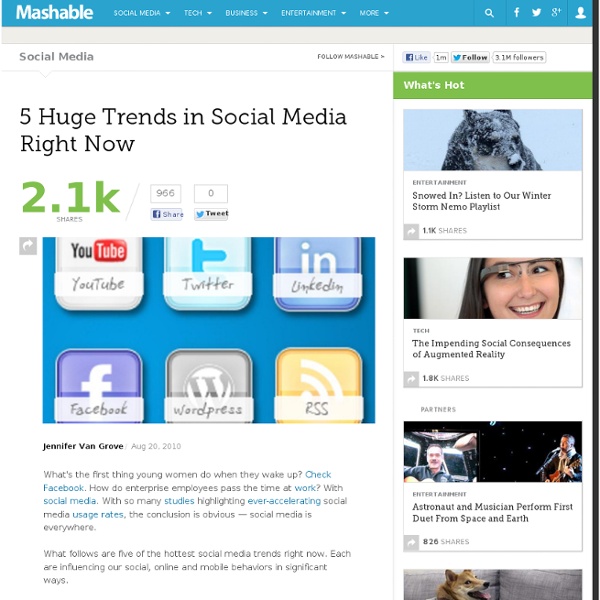The Future of the Social Media Strategist
The Social Media Strategist Series is supported by StrongMail, which helps marketers forge meaningful, profitable and long-lasting connections with customers through e-mail marketing and social media. Learn more here. With evolving corporate social needs comes ever-changing roles for those who identify "social media" as a core part of their job titles. While the social media strategist role is currently a burgeoning career choice across varying industries, some debate the career's longevity. Jeremiah Owyang, an industry analyst with digital strategy consulting firm Altimeter Group, interviewed 140 enterprise-class social strategists for a report on the "Career Path of the Corporate Social Strategist" that hit the web last November. The report found that most interviewees believe that the social strategist role will "fade into the background as social technologies become a ubiquitous communication channel among consumers and companies."
From Facebook to Twitter: Save Your Community From Redundancy
Caroline Chen | March 10, 2011 | 8 Comments inShare107 By understanding the nuances of each platform's digital culture, you can create unique and relevant content, speak the right language, and effectively grow both communities. Of all the social platforms, it's hard to avoid your favorite brand on Twitter or Facebook. There's a page for every living, breathing moment you have: shampoo, face wash, makeup, breakfast, work, lunch, exercise, dinner, entertainment, and sleep. I can't be alone in thinking there's not only a glut of information, but also brand redundancy that still exists across Twitter and Facebook.
How Google+ will succeed and why you’ll use it whether you want to or not. - TNW Google
Editor’s note: This is a guest post written by Tom Anderson, the founder & former President of MySpace. Follow him on Google, Twitter, and Facebook. There’s been more than a few “Google+ is doomed” articles as of late.
101 Social Media Stats to Make Your Spirits Bright and Your Head Spin
Finding the right needle in the haystack that is the Internet is often times an exercise in futility and frustration. Sure, you can find “quick tips” for just about anything, a “how-to” guide for maximizing anything you’d like to maximize, and “case studies” that illustrate someone else’s success story which you believe – for a fleeting moment – you can just as easily apply to your own situation. Most often the tips are oversimplified, the how-to guides leave much to be desired, and the case studies seem to more like exceptions than they are rules. What you really need, at the beginning, middle, and end of the day, is the truth.
Steve Jobs et Apple: omniprésent, mais pas indispensable
Temps de lecture: 5 min Steve Jobs est mort mercredi 5 octobre à l'âge de 56 ans. Avant la nécrologie écrite par notre confrère de Slate.com Farhad Manjoo, nous republions un de ses articles écrit à la fin de l'été, au moment de la démission de Jobs de son poste de PDG, soulignant qu'Apple n'est plus aussi dépendant de son fondateur légendaire que dans le passé et que la société survivrait. Le 25 août, l'action d'Apple a chuté. Ayant couvert la marque à la pomme dans mes articles, l'éthique journalistique m'a interdit d'en profiter pour investir. Mais vous n'avez pas, vous, ce problème; aussi vais-je vous donner un conseil d'ami: achetez!
Steve Jobs Resigns As CEO Of Apple
Title says it all. More to come. For now, the letter from Steve Jobs himself: To the Apple Board of Directors and the Apple Community:I have always said if there ever came a day when I could no longer meet my duties and expectations as Apple’s CEO, I would be the first to let you know. Unfortunately, that day has come.I hereby resign as CEO of Apple. I would like to serve, if the Board sees fit, as Chairman of the Board, director and Apple employee.As far as my successor goes, I strongly recommend that we execute our succession plan and name Tim Cook as CEO of Apple.I believe Apple’s brightest and most innovative days are ahead of it.
Social network
Social networks and the analysis of them is an inherently interdisciplinary academic field which emerged from social psychology, sociology, statistics, and graph theory. Georg Simmel authored early structural theories in sociology emphasizing the dynamics of triads and "web of group affiliations."[2] Jacob Moreno is credited with developing the first sociograms in the 1930s to study interpersonal relationships. These approaches were mathematically formalized in the 1950s and theories and methods of social networks became pervasive in the social and behavioral sciences by the 1980s.[1][3] Social network analysis is now one of the major paradigms in contemporary sociology, and is also employed in a number of other social and formal sciences.
PayPal On Barriers To Google Wallet: Mass Adoption Of NFC Is Years Away
As you may have read, Google officially launched its mobile payments platform Google Wallet recently, which allows you to pay for products in the real world by tapping your NFC-enabled Android phone against a compatible card reader. Shortly following the initial announcement of the technology in May, payments giant PayPal went on the offensive, filing a lawsuit against Google and two former PayPal executives who now are in charge of mobile payments at Google. Allegations of “misappropriation of trade secrets, and “breach of fiduciary duty” were thrown out against these individuals. Clearly, it’s messy. While the lawsuit itself spoke volumes about PayPal’s view on Google Wallet, the eBay-owned company has not really commented on Google Wallet over the past few months.



